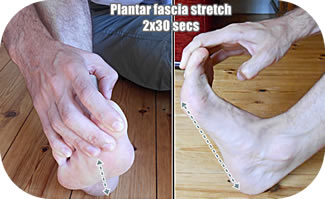Stretch
 Most people who have problems with their Plantar Fascia have persistently tight muscles in their back, hips, hamstrings, calves, and Achilles tendons. Professionals believe that even tightness through the shoulders can play a role in the development of this condition.
Most people who have problems with their Plantar Fascia have persistently tight muscles in their back, hips, hamstrings, calves, and Achilles tendons. Professionals believe that even tightness through the shoulders can play a role in the development of this condition.
Basically if any of your muscles are tense, it throws off your musculoskeletal system by changing your alignment and the way your foot strikes the ground. It would be very beneficial to designate some of your time for a total body stretching routine. Nonetheless, if a total body stretch does not work for you, just performing stretches for your legs and feet will relieve your pain from Plantar Fasciitis.
The following list contains some instruction for some beneficial stretches, but if at any point, one of these stretches causes you unbearable pain, stop immediately, and re-evaluate the stretch or consider visiting a doctor:
- Stretch before stepping out of bed: Plantar Fasciitis can be painful all day, but can be especially bad in the morning. When you step out of bed with tight, rigid muscles, you aggravate your plantar fascia ligament. If this happens every morning, it continues the cycle of pain and inflammation because it doesn’t get enough time to rejuvenate. Before getting out of bed in the morning, first, sit up and flex your feet. Then with a strap (if you do not have a strap, a belt or hand towel will work fine) under your flexed feet, start pulling your feet toward your body until you feel a good stretch in your calves and Achilles tendons. Hold this stretch for 30 seconds, then repeat a couple more times with a little rest in between each one.
- Calf Stretches: When your calf muscles are tight, they cause stress to the heel bone because it is being pulled, therefore making the plantar fascia tense and prone to injury. Stretching the lower leg muscles is one of the best things you can do in order to recover. First, stand facing a table, place your hands palm down on the table and slide one of your legs back pushing your heel down until you feel a stretch in your lower leg. Hold this for 30 seconds and repeat 3 times for each leg. If you feel that you can handle a deeper stretch, you can bend your knees which will also allow you to stretch the lower areas of the legs.
- Plantar Fascia Stretches: Stretching the Plantar Fascia will help loosen up the muscles and tissues and relieve some of the pain. With your hand, pull your toes up until you feel a stretch in the ball of your foot, you may even feel the stretch all the way to your heel. Hold this stretch for at least 30 seconds and repeat at least 3 times.
- Hamstring Stretch: Standing Stretch: Stand up straight and simply bend forward from the waist. You should let the arms dangle down by your sides and make sure to keep your legs straight. Reach for your toes, but if you cannot make it all the way down to touch them, do not force yourself to. It is not necessary to cause yourself more pain. This stretch should provide a nice, gentle release across the back of the hamstrings. It is important to hold each stretch for at least 10 seconds and repeat a few times. For a less strenuous version of this stretch, you can sit in a chair and stretch your legs straight out in front of you. Gently reach forward and try to touch your toes. You can even do this with one leg at a time to make it easier and less stressful on the back and core muscles.
- Back Stretch: Prone Press Up: Lie on the floor with your elbows bent and palms placed down on the ground. Then, lift your upper torso off the ground making sure to keep your hips and legs in contact with the ground beneath you. Make sure to keep all of your muscles relaxed and never push yourself to go further than what is comfortable for you. Hold for 10-30 seconds. Repeat at least 10 times.

